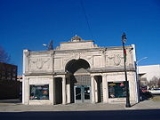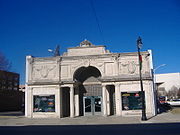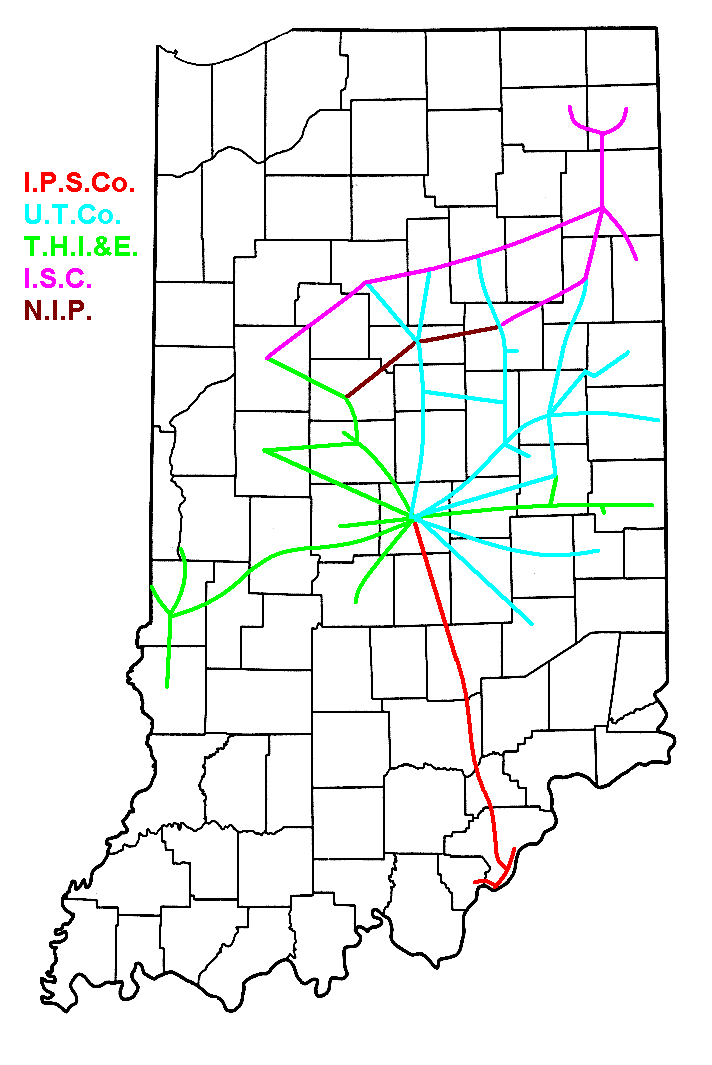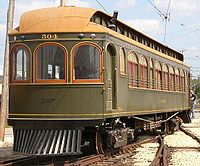
Terre Haute, Indianapolis and Eastern Traction Company
Encyclopedia

Interurban
An interurban, also called a radial railway in parts of Canada, is a type of electric passenger railroad; in short a hybrid between tram and train. Interurbans enjoyed widespread popularity in the first three decades of the twentieth century in North America. Until the early 1920s, most roads were...
in the state of Indiana
Indiana
Indiana is a US state, admitted to the United States as the 19th on December 11, 1816. It is located in the Midwestern United States and Great Lakes Region. With 6,483,802 residents, the state is ranked 15th in population and 16th in population density. Indiana is ranked 38th in land area and is...
at the height of the "interurban era." This system included over 400 miles of track, with lines emanating from Indianapolis
Indianapolis
Indianapolis is the capital of the U.S. state of Indiana, and the county seat of Marion County, Indiana. As of the 2010 United States Census, the city's population is 839,489. It is by far Indiana's largest city and, as of the 2010 U.S...
to the east, northwest, west and southwest as well as streetcar lines in several major cities. The THI&E was formed in 1907 by the Schoepf-McGowan Syndicate as a combination of several predecessor companies, and operated independently until incorporation into the Indiana Railroad
Indiana Railroad
This article is for the electric interurban railroad of 1930-1941. For the currently operating freight railroad Indiana Rail Road see Indiana Rail Road....
in 1931. The THI&E served a wide range of territory, including farmlands in central Indiana, the mining region around Brazil
Brazil, Indiana
Brazil is a city in Clay County, Indiana, United States. The population was 7,912 at the 2010 census. The city is the county seat of Clay County. It is part of the Terre Haute Metropolitan Statistical Area...
, and numerous urban centers. Eventually it succumbed, like all of the other central Indiana interurban lines, to competition from automobiles and trucks and improved paralleling highways.[1][2]
Consolidation

Danville, Indiana
Danville is a town in Center Township, Hendricks County, Indiana, United States. The population was 9,001at the 2010 census. The town is the county seat of Hendricks County. -History:...
; the Indianapolis and Eastern Railway, with lines from Indianapolis east to Dublin
Dublin, Indiana
Dublin is a town in Jackson Township, Wayne County, Indiana, United States. The population was 790 at the 2010 census.-Geography:Dublin is located at ....
and from Dunreith
Dunreith, Indiana
Dunreith is a town in Spiceland Township, Henry County, Indiana, United States. The population was 177 at the 2010 census.-Geography:Dunreith is located at ....
to New Castle
New Castle, Indiana
As of the census of 2000, there were 17,780 people, 7,462 households, and 4,805 families residing in the city. The population density was 2,987.5 people per square mile . There were 8,042 housing units at an average density of 1,351.3 per square mile...
; the Richmond Street and Interurban Railway, with the line in eastern Indiana from Dublin to Richmond
Richmond, Indiana
Richmond is a city largely within Wayne Township, Wayne County, in east central Indiana, United States, which borders Ohio. The city also includes the Richmond Municipal Airport, which is in Boston Township and separated from the rest of the city...
; and the Indianapolis Coal Traction Company. Three weeks later the THI&E acquired the Terre Haute Traction and Light Company, which operated a line from Terre Haute
Terre Haute, Indiana
Terre Haute is a city and the county seat of Vigo County, Indiana, United States, near the state's western border with Illinois. As of the 2010 census, the city had a total population of 60,785 and its metropolitan area had a population of 170,943. The city is the county seat of Vigo County and...
south to Sullivan
Sullivan, Indiana
Sullivan is a city in Hamilton Township, Sullivan County, Indiana, United States. The population was 4,617 at the 2000 census. It is part of the Terre Haute Metropolitan Statistical Area. The city is the county seat of Sullivan County...
, north to Clinton, Indiana, and west to Paris, Illinois. In April 1907 the Schoepf-McGowan Syndicate leased the Indianapolis and Northwestern Traction Company, a system of over 90 miles with lines from Indianapolis to Lafayette
Lafayette, Indiana
Lafayette is a city in and the county seat of Tippecanoe County, Indiana, United States, northwest of Indianapolis. As of the 2010 census, the city had a total population of 67,140. West Lafayette, on the other side of the Wabash River, is home to Purdue University, which has a large impact on...
and from Lebanon
Lebanon, Indiana
Lebanon is a city in and the county seat of Boone County, Indiana, United States. The population was 15,792 at the 2010 census. The city was named Lebanon because a stand of hickory trees on the site reminded one of the town's commissioners of the Biblical cedars of Lebanon...
to Crawfordsville
Crawfordsville, Indiana
Crawfordsville is a city in Union Township, Montgomery County, Indiana, United States. As of the 2010 census, the city had a population of 15,915. The city is the county seat of Montgomery County...
, and purchased the Indianapolis and Martinsville Rapid Transit Company, which ran between the cities in its name. The final major piece of the THI&E was the 1912 addition of the Indianapolis Crawfordsville and Danville Electric Railway, nicknamed the "Ben Hur Route" in honor of Lew Wallace
Lew Wallace
Lewis "Lew" Wallace was an American lawyer, Union general in the American Civil War, territorial governor and statesman, politician and author...
of Crawfordsville, author of the novel "Ben Hur."

Operations
The THI&E was a very typical MidwesternMidwestern United States
The Midwestern United States is one of the four U.S. geographic regions defined by the United States Census Bureau, providing an official definition of the American Midwest....
interurban line, operating far-flung lines out of Indianapolis to midsized prairie cities using long wooden combines
Combine car
A combine car in North American parlance, most often referred to simply as a combine, is a type of railroad car which combines sections for both passengers and freight....
. Trackage quality varied, with some hill and dale side-of-road operation contrasting with fairly major earthworks in hillier sections of the line. Main lines had color light block signals, rare for many interurbans, even those more financially viable like the Cincinnati and Lake Erie. Most passenger service was hourly, and main routes also saw some express service. The express to Terre Haute was named the "Highlander." The "Ben Hur Special" ran to Crawfordsville, and the "Tecumseh Arrow" ran to Lafayette. The THI&E was never prosperous enough in the 1920s to replace its aging fleet of wood interurban cars but many were rebuilt and modernized, and much of the town streetcar line system was reequipped with one-man Birney
Birney
A Birney or Birney Safety Car is a type of streetcar that was manufactured in the United States in the 1910s and 1920s. The design was small and light and was intended to be an economical means of providing frequent service at a lower infrastructure and labor cost than conventional streetcars...
streetcars. When Indiana Railroad absorbed THI&E, both its trackage, freight facilities, and equipment were improved or replaced by IR. THI&E's large wood passenger combines (passenger+freight in one car) with their prominent cow catchers were retired or converted to freight box motors. [1] The IR's former THI&E line eastward to Richmond connected to the Dayton and Western/Ohio interurbans and was important trackage for IR's critical freight business.[2]
Decline and Absorption
The THI&E was perhaps the weakest of the great Indiana interurban systems. During the 1920s its consistent operating deficits were offset only by the sale of power from its power stationPower station
A power station is an industrial facility for the generation of electric energy....
s and by the profits of the Indianapolis Street Railway, a subsidiary
Subsidiary
A subsidiary company, subsidiary, or daughter company is a company that is completely or partly owned and wholly controlled by another company that owns more than half of the subsidiary's stock. The subsidiary can be a company, corporation, or limited liability company. In some cases it is a...
company. The company went into receivership
Receivership
In law, receivership is the situation in which an institution or enterprise is being held by a receiver, a person "placed in the custodial responsibility for the property of others, including tangible and intangible assets and rights." The receivership remedy is an equitable remedy that emerged in...
on April 2, 1930. At this time Samuel Insull
Samuel Insull
Samuel Insull was an Anglo-American innovator and investor based in Chicago who greatly contributed to creating an integrated electrical infrastructure in the United States. Insull was notable for purchasing utilities and railroads using holding companies, as well as the abuse of them...
's Midland Utilities was in the process of consolidating most of the major Indiana interurbans (Indiana Service Corporation/ISC, Union Traction, Interstate/IPS, THI&E) into the Indiana Railroad, but the unprofitable branch line
Branch line
A branch line is a secondary railway line which branches off a more important through route, usually a main line. A very short branch line may be called a spur line...
s that made up much of the THI&E did not fit into his master plan. The long west-east Terre Haute-Indianapolis-Richmond line did, but the Danville, Martinsville, Lafayette and Crawfordsville branches were abandoned on October 31, 1930. The lines to Sullivan and Clinton
Clinton, Indiana
Clinton is a city in Vermillion County, Indiana, United States. The population was 4,893 at the 2010 census. The city was established in 1829 and is named after DeWitt Clinton, who served as governor of New York from 1817 to 1823. Many of Clinton's original settlers were immigrants working in coal...
were abandoned early the next year. In June 1931, the THI&E was acquired by Midland Utilities and was incorporated into the Indiana Railroad. The last former THI&E line was abandoned in 1940, and the Indiana Railroad abandoned all operations in 1941.[2]
External links
- http://www.davesrailpix.com/odds/in/in.htm#thie THI&E photos from Dave's Electric Railroads
- http://donsdepot.donrossgroup.net/dr1836.htm THI&E photos from Don Ross' Rail Photos
- http://www.indianahistory.com/ihs_press/web_publications/railroad/index.html Indiana Railroad Society historical articles and maps regarding Indiana interurban lines.

